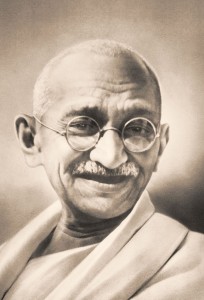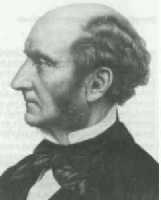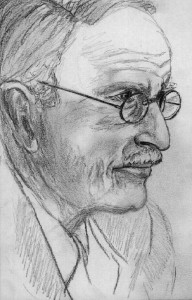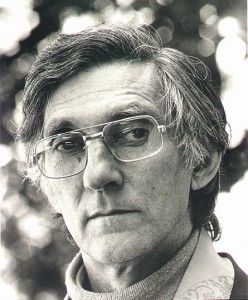Was Jesus a Middle Way Thinker? Largely not. His beliefs seem to have included many absolutes, and he has also been interpreted since in terms of those absolutes. Yet in this series I also want to encourage incremental thinking. I want to suggest that there are some important ways in which Jesus moved forward from the dogmas of his time, which amount to some specific instances of Middle Way thought. I’d suggest that it is due to these new ways that he addressed the conditions of his time that he gets much of his power. Particularly for those of us from a Christian background (which includes me), I think it’s important to re-examine Jesus in a critical way: one that tries to separate out the dogmas of Christian tradition from those elements that might helpfully speak to our experience.
However, this is a loaded subject, so I’d better start with some clarifications. On the one hand, I’m not interested in supporting any of the dogmas of the Christian tradition about Jesus: either that he was the Son of God, affirmed as some type of supernatural status, or that everything he uttered was ‘true’ and the Word of God. But nor, on the other hand, am I interested in historical revisionism, which seems to be the opposite trap for those interested in re-examining Jesus. I don’t want to make any claims about what Jesus “really” was, or believed, or meant to say. I’m content to work with the Jesus accepted by Christian tradition, and depicted in the four canonical gospels, because that is what ‘Jesus’ effectively means to most people today. I’m looking for insights or symbolic inspiration, rather than historical revelation, in this traditional depiction of Jesus, without getting swallowed up by the various scholarly quagmires of Biblical Studies. The third extreme I’d also want to avoid here, is the mere rejection of Jesus as a source of insights or inspiration. For me, and I suspect many others in the West, Jesus is a powerful archetypal figure, both because of his role in Western art and culture and because of his influence through the Christian churches (very much associated, for me, with childhood experience as a minister’s son).
Let me also briefly note some of the aspects of Jesus that I think are pretty unhelpful. There’s the virgin birth, the idealised childhood, and the sense of divine destiny as the son of God. There are the miracles: at least where these are presented not as acts of compassion but (as particularly in the gospel of John) as signs of divine status. There’s the self-sacrificial aspect: he appears to have basically offered himself up as a sacrifice, aware that he was walking into a trap that would result in his death in Jerusalem, but still doing it. In his trial before Pilate he also seems guilty of false modesty, not offering even a moderate defence to draw people’s attention to his innocence. It seems possible that he believed God would save him from the cross (accounting for ‘My God! Why have you forsaken me?’), because of his profound belief in cosmic justice and an imminent doomsday. Finally, if we follow the role of Jesus in Christian tradition, there’s the interpretation of Jesus’s death as an atonement for human original sin, and the belief in his resurrection as a further sign of divinity and a proof of eternal life for the saved: all these are damaging dogmas by which the moral complexity of our experience is overlaid with crude diagnoses and crude magical solutions.
But, if we can manage to leave all that stuff aside, let’s try to focus on some of the ways that Jesus can be inspiring and insightful – corresponding also to ways that he moves towards the Middle Way. I’d suggest that these fall into two categories: one of these is helpful elements in Jesus’s moral teaching, and the other is helpful archetypal interpretation of the meaning of Jesus as the Son of God.
Much of Jesus’s moral teaching involves a struggle with the Pharisees, who were a sect of Jewish legalists, and the Sadducees, who were conservatives associated with the priestly elite at the Jerusalem temple. Jesus is excoriating about rigid observance of tradition or adherence to the letter of the law, instead urging awareness of motive and the spirit behind the law. For example, when his disciples plucked ears of corn on the Sabbath (against the laws that forbid harvesting on the sabbath, which would be work) and were criticised by the Pharisees, Jesus said “The Sabbath was made for man, not man for the Sabbath” (Mark 2:27). He also emphasised motive in urging people not to be showy about giving alms, “Your good deed must be secret” (Matthew 6:4). From today’s perspective, to merely emphasise motive in ethics is not enough, because our motives vary so much along with our unintegrated desires. However, this emphasis was a major step forward in a context where people were thinking of ethics only as an extension of law, in the form of rigid social rules. On the other hand, Jesus seems to be trying to strike a Middle Way in relation to the Jewish Law, because he does not reject it either: “Do not suppose that I have come to abolish the law and the prophets; I did not come to abolish, but to complete” (Matthew 5:17).
Jesus is also well-known for his teaching of ‘turning the other cheek’ – the apparent pacifism of “Do not resist those who wrong you. If anyone slaps you on the right cheek, turn and offer him the other also” (Matthew 5:39). The key insight here is the necessity of avoiding fruitless conflict. Rather than offering one rigid position in response to another, we need to find ways of reducing (an not acting on) the narrow egoistic identification we may have with ‘winning’ when someone challenges us. However, I also think that the Pacifist interpretation of this verse develops another kind of dogma. If we read it as forbidding violence in all circumstances whatsoever, then we rule out the possibility of violence addressing conditions in some circumstances where it might be the best response.
Jesus also offers what might be regarded as a brief equivalent to the Kalama Sutta in Buddhism, offering the suggestion that we need to consult experience when confronted with a conflict between different dogmatic claims. “Beware of false prophets, who come to you dressed as sheep while underneath they are savage wolves. You will recognise them by their fruit. Can grapes be plucked from briars, or figs from thistles? A good tree always yields sound fruit, and a poor tree bad fruit” (Matthew 7:15-17). Here he seems to be suggesting that verbal claims are not enough, and one of the ways we can judge the justification of conflicting claims is by their integration, evident in people’s behaviour. Again, we could take this to another extreme, by rejecting a person’s view whenever there is a shade of hypocrisy. Hypocrisy does not necessarily make people’s claims untrue, but it is a useful warning sign.
Much more could be said about Jesus’ moral teaching, but I must keep this post brief. More broadly, too, I think Jesus’ symbolic role should also be mentioned. His traditional position in Christianity as ‘Son of God’, both wholly human and wholly divine (according to the Nicene Creed) does not have to be merely rejected as a dogmatic belief, because its meaning can be separated from such beliefs. That meaning is one I encounter very frequently in Renaissance art, where I encounter Jesus as what sometimes seem to be an attempt to represent the Middle Way in human experience. The symbolic richness of Jesus’s status as both divine and human is one way of confronting the profound ambiguity of the relationship between perfect ideals and imperfect experience, the ‘truth on the edge’, or necessity of maintaining a robust conception of truth without claiming to possess it. Jesus is full of contradictions: he is both vulnerable and powerful, wise and foolish, alive and dead, but these contradictions are only damaging as objects of incoherent belief. As symbols, on the other hand, their ambiguity can help us to recognise both the conflicts in our own experience and the ways we can work with those conflicts.
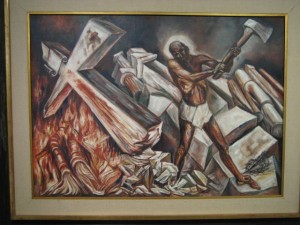 Western art often depicts Jesus in three particular forms: as an infant, in his crucifixion, and in his resurrection. All of these, I think, can be appreciated as offering evocations of that symbolic richness. As an infant he represents the incarnation, that strange ambiguous middle way between divine and human. On the cross he represents the unbearable and unjust suffering of the human condition when understood in relation to divine perfection. When resurrected, he shows the perseverance of hope: that the good can still come through human experience even when we least expect it, when we have come to terms with the conditions of human life. The picture here is an intriguing one by the Mexican artist Orozco. There are many ways of reading it, either as a symbol of resurrection, or as an anti-theistic statement in which mere humanity triumphs.
Western art often depicts Jesus in three particular forms: as an infant, in his crucifixion, and in his resurrection. All of these, I think, can be appreciated as offering evocations of that symbolic richness. As an infant he represents the incarnation, that strange ambiguous middle way between divine and human. On the cross he represents the unbearable and unjust suffering of the human condition when understood in relation to divine perfection. When resurrected, he shows the perseverance of hope: that the good can still come through human experience even when we least expect it, when we have come to terms with the conditions of human life. The picture here is an intriguing one by the Mexican artist Orozco. There are many ways of reading it, either as a symbol of resurrection, or as an anti-theistic statement in which mere humanity triumphs.
I have passed through a number of stages in my response to Jesus. As a child and teenager, I mainly had a negative reaction to the idealised figure I was presented with, who was being foisted on me, but didn’t at all seem to represent the qualities I would have chosen to idealise or to worship. At times, however, I also tried out that idealisation, though I had great difficulty making it my own. I then started to see Jesus primarily as a swindle: an attempt to magically jump across the difficulties of human life. Now, however, I’m quite clear about rejecting a lot of the religious claptrap that surrounds beliefs around Jesus, but at the same time I think I am beginning to develop a relationship with him both as a man and as an icon. As a moral teacher, he can be inspiring, but does not seem to me as hugely significant as he is often cut out to be, and a lot of contextualisation is needed to see how he was moving towards the Middle Way. As an archetypal symbol, though, he means a lot more, and that meaning develops a little almost every time I step into an art gallery.
Postscript (2018)
This article was written in 2014, and since then I have written a whole book, The Christian Middle Way, that is now being published. In that book I give a much more detailed interpretation of Jesus with rather more reference to the gospels. Although this article gives an idea of the direction I was heading in a couple of years before I wrote the book, the view of Jesus that I arrived at subsequently is in many respects more positive than this one.
Robert M. Ellis
